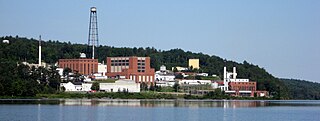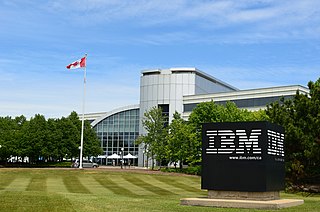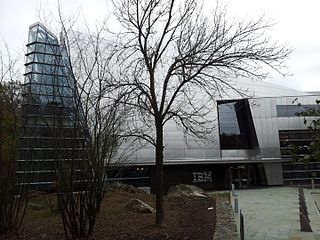Related Research Articles

A local area network (LAN) is a computer network that interconnects computers within a limited area such as a residence, school, laboratory, university campus or office building. By contrast, a wide area network (WAN) not only covers a larger geographic distance, but also generally involves leased telecommunication circuits.

The BeiDou Navigation Satellite System (BDS) is a Chinese satellite navigation system. It consists of two separate satellite constellations. The first BeiDou system, officially called the BeiDou Satellite Navigation Experimental System and also known as BeiDou-1, consists of three satellites which since 2000 has offered limited coverage and navigation services, mainly for users in China and neighboring regions. Beidou-1 was decommissioned at the end of 2012.

IBM Research is IBM's research and development division. It is the largest industrial research organization in the world, with twelve labs on six continents.

Chalk River Laboratories is a Canadian nuclear research facility in Deep River near Chalk River, about 180 km (110 mi) north-west of Ottawa.

The Thomas J. Watson Research Center is the headquarters for IBM Research. The center comprises two sites, with its main laboratory in Yorktown Heights, New York, U.S., 38 miles (61 km) north of New York City and with offices in Cambridge, Massachusetts.
Extreme Blue is one of IBM's internship program for both graduate and undergraduate students; it also serves as a placement opportunity for future IBM employment due to the significant effort put into placement of the interns.

IBM Canada's head offices are currently located in Markham, Ontario and have been there since the early 1980s. The current building IBM occupies is located at 3600 Steeles Avenue East and was completed in 1995. IBM Canada's previous head office was located across the street at 3500 Steeles Avenue East.
The IBM Cambridge Scientific Center was a company research laboratory established in February 1964 in Cambridge, Massachusetts. Situated at 545 Technology Square, in the same building as MIT's Project MAC, it was later renamed the IBM Scientific Center. It is most notable for creating the CP-40 and the control program portions of CP/CMS, a virtual machine operating system developed for the IBM System/360-67.
Liang-Jie (LJ) Zhang is a computer scientist, a former Research Staff Member at IBM Thomas J. Watson Research Center, Senior Vice President, Chief Scientist, & Director of Research at Kingdee International Software Group Company Limited, and previously a director of The Open Group.
The Center for Research Libraries is a consortium of North American universities, colleges, and independent research libraries, based on a buy-in concept for membership of the consortia. The consortium acquires and preserves traditional and digital resources for research and teaching and makes them available to member institutions through interlibrary loan and electronic delivery. It also gathers and analyzes data pertaining to the preservation of physical and digital resources, and fosters the sharing of expertise, in order to assist member libraries in maintaining their collections. The Center for Research Libraries was founded in 1949, as the Midwest Inter-Library Center (MILC). The traditional role of the CRL was as an aggregator of tangible collection materials, however this has been updated in the digital age into the CRL's current role as a facilitator of collection development, digitization, and licensing collections by individual libraries and interest groups. This transformation required the CRL to adopt new funding models from partnerships with key organizations, and an updated use of current technology to support community outreach and engagement. The funding was provided by the Andrew W. Mellon Foundation, the National Science Foundation, and the IMLS.
FlexOS is a discontinued modular real-time multiuser multitasking operating system (RTOS) designed for computer-integrated manufacturing, laboratory, retail and financial markets. Developed by Digital Research's Flexible Automation Business Unit in Monterey, California, in 1985, the system was considered to become a successor of Digital Research's earlier Concurrent DOS, but with a new, modular, and considerably different system architecture and portability across various processor families. Still named Concurrent DOS 68K and Concurrent DOS 286, it was renamed into FlexOS on 1 October 1986 to better differentiate the target audiences. FlexOS was licenced by several OEMs who selected it as the basis for their own operating systems like 4680 OS, 4690 OS, S5-DOS/MT and others. Unrelated to FlexOS, the original Concurrent DOS system architecture found a continuation in successors like Concurrent DOS XM and Concurrent DOS 386 as well.
IBM India Research Laboratory (IRL) is one of IBM's eight major worldwide research laboratories. It was established in 1998 in Delhi, India.
The IBM Research – Tokyo, which was called IBM Tokyo Research Laboratory (TRL) before January 2009, is one of IBM's twelve major worldwide research laboratories. It is a branch of IBM Research. About 200 researchers work for TRL.
The legal and cultural expectations for date and time representation vary between countries, and it is important to be aware of the forms of all-numeric calendar dates used in a particular country to know what date is intended.
Daniel F. Spulber is the Elinor Hobbs Distinguished Professor of International Business and professor of strategy at the Kellogg School of Management, where he has taught since 1990. Spulber is also professor of law at the Northwestern University School of Law and research director of the Searle Center on Law, Regulation, and Economic Growth. He is the founding editor-in-chief of the Journal of Economics & Management Strategy.
IBM Research – Ireland is one of IBM Research's twelve worldwide research laboratories, a first for the European Union and the only one which focuses on smarter technology for cities.

IBM is an American multinational information technology company headquartered in Armonk, New York, with operations in over 170 countries. The company began in 1911, founded in Endicott, New York, as the Computing-Tabulating-Recording Company (CTR) and was renamed "International Business Machines" in 1924. IBM is incorporated in New York.
IBM Research – Africa is one of twelve research laboratories comprising IBM Research. Located at the Catholic University of Eastern Africa in Nairobi, it opened on November 7, 2013. It is the first commercial technology research facility on the African continent conducting both applied and far-reaching exploratory research.

Summit or OLCF-4 is a supercomputer developed by IBM for use at Oak Ridge National Laboratory, which as of November 2018 was the fastest supercomputer in the world, capable of 200 petaFLOPS. Its current LINPACK benchmark is clocked at 148.6 petaFLOPS. As of November 2018, the supercomputer is also the 3rd most energy efficient in the world with a measured power efficiency of 14.668 gigaFLOPS/watt. Summit is the first supercomputer to reach exaop speed, achieving 1.88 exaops during a genomic analysis and is expected to reach 3.3 exaops using mixed precision calculations.
References
- ↑ "Labs and Locations". 2018-06-05.
- ↑ Spulber (2007), p. 185
- ↑ "IBM Research - China - Locations".
- ↑ "IBM 如何成就你的事业巅峰 - 中国". www-07.ibm.com (in Chinese). 2018-03-27. Retrieved 2018-05-03.